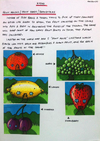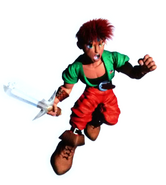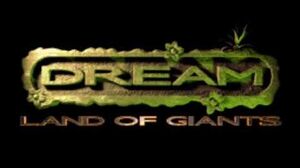
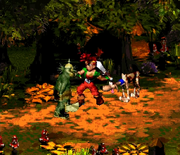
A screenshot of a clip of Dream shown in a video made by Rare
Dream: Land of Giants (Codenamed "Project Dream") was an unreleased RPG video game that was originally in development for the Super NES but was moved to the Nintendo 64. The game's team spent around 16 months developing the game, after which it was redeveloped into what is now Banjo-Kazooie.
Around the time of Rare Replay's release in 2015, Rare recorded a making-of featurette entitled "A Rare Look at Dream" which divulged exciting insights into the game's development history, inspirations, and evolution into Banjo-Kazooie. Steve Mayles has kindly shared numerous promotional images of the game's character designs via social media, and Grant Kirkhope has uploaded many of the themes he composed for the game to his portfolio website along with commentary on each track. In July 2015, storyboard images, concept art sheets, and a blank sprite floppy of Dream surfaced on eBay UK.[1]
The seafaring themes explored while developing the N64 version of Dream would later be used as inspiration for Rare's Sea of Thieves, which was revealed at E3 2015.
Development[]
Phase 1 - Dream: Land of Giants (SNES)[]
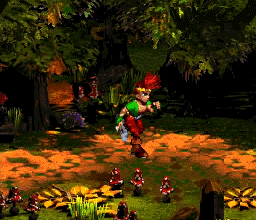
Edson running along a wooded path in the first version of Dream (SNES)
The team behind Donkey Kong County 2 began production on Dream: Land of Giants for the Super Nintendo Entertainment System around the end of 1995. Their aim was to apply the pre-rendered bitmap graphic style they developed for the Donkey Kong Country series to a different genre of game, while pushing the graphical fidelity even higher than what they had achieved on their previous two projects. Drawing inspiration from Japanese RPGs, The Legend of Zelda, and LucasArts point-and-click adventure games, the team dreamt up the idea of a sprawling isometric adventure game with a "fairytale-esque magical element to it."[2]
The team developed a demo of the game for the SNES, featuring a full introduction sequence and one level. The player controlled a sword-wielding boy named Edson who was assisted by his newly-befriended pet dog Dinger. Dinger would have had a wide range of abilities, being able to dig for buried objects and scamper off independently from the playable character. The level contained a lush forest and a swamp, and was populated by trolls (designed by Ed Bryan) and a gigantic dinosaur whose foot would occasionally stomp down into view, threatening to crush Edson.
The demo boasted a number of impressive visual effects, for example pre-rendered shadow sprites that were dynamically blended with the character sprites, simulating dappled light shining through leaves. Commenting on the demo, composer Grant Kirkhope said he "was blown away. It looked beautiful and a step up above the Donkey Kong Country games."
Since Edson himself had very few moves in comparison with the non-playable character Dinger, the team felt that the gameplay was unbalanced and would benefit from folding "all the abilities back onto a single character"[3] - an idea that they would later fulfil in Banjo-Kazooie by allowing the player to effectively control two characters under a single control scheme.
According to Kirkhope a copy of the demo cartridge may still be locked away somewhere at Rare's headquarters. Tim Stamper is also known to have a working copy of the demo - in 2015 he teased fans with a series of humorous photos of his attempts to "capture" the wiley googley-eyed cartridge after it escaped from storage in his home. Eventually Stamper uploaded photos of the cartridge itself along with an opened view showing its internal circuitry and four ROM chips, and he shared photos of the demo's title screen running on his SNES.
Phase 2 - Dream (N64)[]
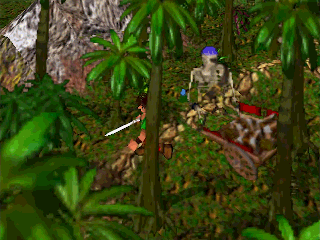
An early N64 build of Dream
Shortly after completing the SNES demo, the team decided to switch the project from the now-aging SNES to the upcoming N64. According to designer Steve Mayles: "the introduction of the Nintendo 64 made [pre-rendered graphics] obsolete, so we switched development over to the new machine after only a few months."[4] The game's tone shifted during this phase; the team were worried that the fairy tale world they had first invisioned might not appeal to a wide enough variety of audiences, so they gradually moved towards pursuing a harder-edged "piratey theme."[5] The "Land of Giants" aspect of the game was dropped, and Captain Blackeye and his scurvy crew emerged as the game's antagonists.

Edson's updated character model in a later build of Dream (N64)
The game featured a unique 3D terrain system: similar to how the team constructed backgrounds for the Donkey Kong Country series via a tileset of tiny prerendered sprites pieced together in a grid-like pattern, environments in Dream were created using grids of polygons so that each quad could have a unique prerendered texture assigned to it, with each of the grid vertices then displaced vertically to create a rolling landscape of hills and valleys.
Moving from the SNES to the N64 was apparently a surprisingly smooth process for the team, presumably since the isometric style used in the former version and the grid-like style imployed in the latter version meant that some sections of SNES-era code could readily be adapted for the N64.[6]
Grant Kirkhope had composed over 100 pieces of music for the game by this point in development, including an introductory song for the game's villain which was animated via motion capture and sung by one of the game's artists. Many of Kirkhope's unused themes from the game have been repurposed for subsequent titles, including the Banjo-Kazooie series, Donkey Kong 64, and Viva Piñata.
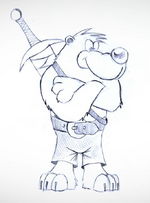
An early design for a sword-wielding adventurous Banjo
This version of the game eventually ran into a number of difficulties. According to engineer Paul Machacek (who joined the team at the start of this phase) a lot of time had been spent writing level editors and creating environments, but the team "couldn't quite get a hook of a game". Designer Steve Mayles felt that Edson was out-of-place among the cast of pirates and that he was "too generic" and nondescript to begin with, so the team experimented with replacing the boy with an animal protagonist. At first they tried recycling existing designs for non-playable characters, including "a dopey dog, a rabbit that looked like a man, and a bear." They gave the bear (who would eventually become Banjo) a backpack for storing his adventuring items, and had him become the new protagonist of Dream. A key difficulty still remained, however: the game was far too ambitious.
"Dream continued for around another year [after switching to the N64], before we realised that the scope of the game and the early choices we had made regarding technology meant it was going to take many years to complete,"[7] explained Gregg Mayles. "We really liked the bear, we really liked the character so we thought 'can we come up with another game that we feel more confident we can build in a reasonable timeframe?' Then we just took Banjo out of Dream and […] put him in the game that eventually became Banjo."[8]
Phase 3 - Kazoo (N64)[]
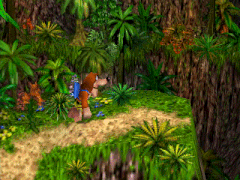
Banjo ollies over a pit, and a familiar feathered friend lends her assistance
Around the beginning of 1997, the team scrapped the pirate-themed iteration of Dream and began developing a more action-oriented adventure game centred on Banjo's abilities. The game "changed into something we were more familiar with, which was a kind of 2.5D [platformer]," Ed Bryan commented. "It was gameplay that we were better-suited to do."
Kazooie seems to have been introduced around this time. The game's designers wanted Banjo to have a double-jump, so they had a pair of wings magically emerge from his backpack to accomplish this. They also wanted Banjo to be able to move very quickly at times, so they created a move where a pair of legs stick out of his backpack. Putting those two ideas together, they decided that a bird (initially named "Tweeter") should live in Banjo's backpack. According to Gregg Mayles' design documents, this game was to be titled "Kazoo".
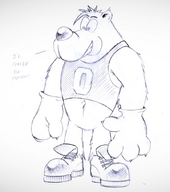
Banjo's moves and clothes were going to be sports-themed
This version of the game reused the grid-based polygonal environment technique developed for the N64 version of Dream, but the levels were given a much more linear DKC-esque structure with a clearly defined start point and end goal. Banjo adopted a skateboarder aesthetic: his jump animation resembled a skater performing an ollie (only without any skateboard), and he would wear a baseball cap and oversized skater shoes alongside his characteristic yellow shorts. The game's health meter would be indicated through his clothing - after one hit he'd lose his hat, a second hit lost him his shoes, and a third hit resulted in death. Jigsaw pieces were present as primary collectible items at this point, as well as a variety of collectible fruit. Banjo's moveset allowed him to cartwheel and handspring around levels, and he would have had a "sparkle jump" that could be performed by rotating the control stick before jumping (similar to a movement ability in Super Mario Sunshine). Analagous to the throwable barrels in DKC, Banjo would have been able to pick up soccer balls/water balloons/bowling balls/etc. and hurl them at enemies. The game was going to have a DKC-style overworld, divided into several islands.
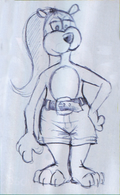
An early sketch of Piccolo
It wasn't long before this version of the project was also scrapped. According to Chris Sutherland "there were two months […] where we experimented with using Dream visual technology to create the game, then we altered our approach to better accommodate the design."[9] The grid-based visual style would require many polygons to be on-screen, and the Nintendo 64 lacked the processing power needed to maintain these environments at a steady frame rate.[10] After seeing an early version of Super Mario 64, the team felt that Kazoo looked outdated by comparison. Meanwhile, Rareware's other 3D platformer project Twelve Tales: Conker 64 (which was being developed by the Killer Instinct team and would eventually become the adult-oriented Conker's Bad Fur Day) also seemed to be progressing much more smoothly than the Dream team's efforts. Motivated by these two games' successes, the team decided to revamp their game one more time.
A screenshot of Kazoo was included as an easter egg in the final Banjo-Kazooie, which can be seen above the bedstand in Banjo's House.
Phase 4 - Banjo-Kazoo (N64)[]
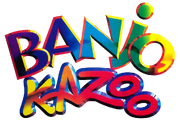
The original logo for "Banjo-Kazoo"
From around March 1997 onwards the team created the finished version of Banjo-Kazooie. "Banjo-Kazoo" was the team's original name for the game, but this had to be changed due to copyright difficulty.[11]
Within one week of their decision to revamp the game, the team managed to assemble an early playable version of what became Spiral Mountain. A Temple Test level was quickly created to experiment with the game's 3D engine and control system, featuring statues that were recycled from troll models created for the SNES version of Dream. Mumbo's Mountain, Treasure Trove Cove, Clanker's Cavern, and Bubblegloop Swamp all seem to have been drafted very early on in the game's development cycle based on clips that have been released which feature an earlier version of Banjo's character model. A number of levels that were originally planned to appear in Banjo-Kazooie were shelved until Banjo-Tooie: these included Mayahem Temple,[12] Glitter Gulch Mine, Witchyworld, and Hailfire Peaks - Mayles' design documents suggest that some of these levels were invented as early as July 1997, months before some of Banjo-Kazooie's other levels were finalised.
Although the game changed enormously since they began development in 1995, ironically the team had circled back around to the earliest version of Dream's fairy tale inspirations by including a witch as the game's villain. Furthermore, originally Banjo was going to be transformed into a frog after the final boss battle, and his sister Tooty would have gone on a secondary adventure in order to turn him back into a bear.[13]
Plot[]
Dream: Land of Giants, while not offering too much of a story, tells the tale of a boy adventurer by the name of Edson who, along with his girlfriend, Madeleine and their recently-found pet dog Dinger, gets tangled up with a bunch of no-good pirates named Flintlock Jock, Grim Jim, and their leader, the infamous Captain Blackeye, who commands the pirate ship known as the Mudplugger. Blackeye and his crew wanted to design a ship which could fly to improve their ease of travel and conquer territory more effectively. For such a feat to be achieved, they would make the ship out of a material known as "floatsy" (Possibly inspiring the creation of the Floatus Floatium from Banjo-Tooie).
Characters[]
- Edson[14] - The main character for the SNES version. He got himself in trouble with a crew of pirates lead by Captain Blackeye.
- Madeleine - Edson's girlfriend
- Banjo - He was originally designed to be a secondary character. However, he would later appear in his own game alongside Kazooie.
- Captain Blackeye - The infamous captain of a pirate crew and main antagonist of the game. He later appeared as a character in Banjo-Tooie at Jolly's Bar in Jolly Roger's Lagoon. He repeats the words "Arrr! I had a dream once... I were in this fine game... A bear stole me glory... Looked a bit like you, 'e did!", a reference to his original role and the game's eventual conversion into Banjo-Kazooie.
- Grim Jim - One of Blackeye's crew members
- Flintlock Jock - A member of Captain Blackeye's band of pirates
- Captain Cockeye - A "good pirate and a bit of a mad professor", as Grant Kirkhope would put it.
- Big Belly - An obese pirate who was part of Captain Blackeye's crew on the Mudplugger. He likes to eat and drink a lot.
- Ripper - Captain Blackeye's pet dog. Excels at ripping things, especially the seats of their victims' pants.
- A strange, unintelligent rabbit - This character was going to be a secondary character in the SNES version, but he was later put under consideration for the main protagonist, when Edson was considered "too generic" and was scrapped.
- Tooty/Piccolo - Tooty was going to appear in the game as Banjo's girlfriend, and her original name was Piccolo, to match her musical instrument. This was later changed to Tooty.
- The Giant - The primary antagonist was originally a giant - this was likely during the SNES phase of development when the game was inspired by fairy tales and had the title "Dream: Land of Giants". Captain Blackeye became the main villain once the barnacle-ridden buccaneering themes emerged, and he was in turn replaced by a wicked witch once the game became Banjo-Kazooie.
- Dinger - A dog who was one of the secondary characters that was under consideration for being the main protagonist when Edson was scrapped. At the beginning of Land of Giants, he was a companion of Edson.
- Tiptup - He was also going to be a secondary character, much like Banjo was.
- Stomponadon - Similar to his appearance in Banjo-Tooie, he stomped on players causing health loss. The clear aim was to avoid him. The threat of attack from Stomponadon in Land of Giants was signalled by the camera shaking and leaves falling.
Other minor characters, such as Bully, were also recently revealed by Grant Kirkhope on his website.
Music[]
Even though Dream was not released, Grant Kirkhope (composer for the music of Banjo-Kazooie) had already composed 107 tunes for it. Some of these songs reappeared in one form or another, in the Banjo-Kazooie series, as well as other Rare games, such as Viva Piñata: Trouble in Paradise, Donkey Kong 64, etc. Grant has released some of these on his website. Alternatively, one can listen to these tracks on YouTube. David Wise was also confirmed to have begun music on the game when it was on the SNES, but was reassigned to work on music for Diddy Kong Racing. Most of the music Wise composed for this game hasn't been found as of yet. However, 2 of Wise's pieces have been included in Rare Replay, which can also be found on Youtube.
In 2018, a user discovered a song in the 2015 Dream of Rare video, a song, possibly a main theme that was to be the definitive main theme of the game.
Gallery[]
References[]
- ↑ http://www.rarefandabase.com/project-dream-sprite-disk-storyboard-and-character-sketch/
- ↑ https://youtu.be/w72kj20YNA0?t=22
- ↑ https://youtu.be/w72kj20YNA0?t=129
- ↑ "The Making of Banjo-Kazooie". Retro Gamer. No. 36. Imagine Publishing. March 2007. pp. 19.
- ↑ https://youtu.be/w72kj20YNA0?t=194
- ↑ "The Making of Banjo-Kazooie". Retro Gamer. No. 36. Imagine Publishing. March 2007. pp. 19.
- ↑ "The Making of Banjo-Kazooie". Retro Gamer. No. 36. Imagine Publishing. March 2007. pp. 19.
- ↑ https://youtu.be/w72kj20YNA0?t=323
- ↑ "The Making of Banjo-Kazooie". Retro Gamer. No. 36. Imagine Publishing. March 2007. pp. 20.
- ↑ https://web.archive.org/web/20160113222025/http://www.gameinformer.com/b/features/archive/2012/10/22/secret-history-of-banjo-kazooie.aspx
- ↑ "The Making of Banjo-Kazooie". Retro Gamer. No. 36. Imagine Publishing. March 2007. pp. 23.
- ↑ https://youtu.be/kq-fpnnGzyU?t=372
- ↑ https://youtu.be/kq-fpnnGzyU?t=482
- ↑ 20 March 2015. @RareLtd on Twitter: "Not sure if that's news, but the boy hero of Project Dream (pre-Banjo) was called Edson, not Edison. #bombshell #probablynotabombshell"






